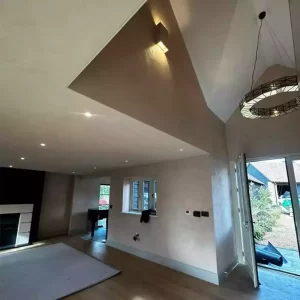Clay Plaster
Clay plaster is an increasingly popular product for interior and exterior design. From its eco-friendly properties to its aesthetic appeal, this article will explain the countless benefits of using clay as your plaster of choice.
What is clay plaster?
Clay plaster – also known as clay render or clay finish, is a natural building material that provides a unique, earthy finish.
It has been used for centuries across various cultures by mixing clay, sand, and sometimes straw or other natural fibres to create a versatile plaster for interior and exterior walls and ceilings.
Unlike traditional gypsum or cement-based plasters, natural clay plaster is environmentally friendly, non-toxic, and breathable.
Clay is renowned for its aesthetic appeal – providing a warm, textured surface that can be left natural or finished with various techniques, such as pigments or lime washes.
Beyond its visual and environmental benefits, a clay finish is often chosen for its easy application and repair.

Why choose clay?
Regulates relative humidity and temperature:
Create a comfortable and healthy living environment as clay adapts to changes in humidity and temperature.
Absorbs toxins and odours:
Purify your indoor air by letting clay act as a natural filter, absorbing toxins and odours to promote a cleaner atmosphere.
Sound absorbing properties:
Enhance the acoustics of your space with clay’s sound-absorbing properties, ensuring a tranquil and peaceful ambience.
Fast application:
Enjoy the convenience of a fast and efficient application, saving you time while delivering exceptional results.

Is clay plaster expensive?
Plaster costs vary depending on the specific type of plaster, the scale of the project, labour costs and regional pricing variations. The product can be slightly more expensive than conventional cement plasters due to the natural and often locally sourced materials.
But, while the upfront cost may be higher, natural clay offers unique advantages, such as its eco-friendly and sustainable nature, breathability, and aesthetic appeal. Long-term benefits include improved indoor air quality and temperature regulation – contributing to a healthier living environment.
To find a market-leading supplier of clay plasters, check out Luna Plaster’s Earth Plaster today.

How strong is clay plaster?
Clay is durable and strong – although its strength is influenced by specific composition, application method and additives used.
Generally, properly mixed and applied clay exhibits good structural integrity. Clay’s strength is often sufficient for typical interior wall applications. It provides a solid, resilient surface that can withstand normal wear and tear.
It’s worth noting that while clay may not be recommended for high-traffic or wet areas, it excels in providing a breathable and flexible finish, making it well-suited for various interior applications.
If you have specific concerns about the strength requirements for your project, consulting with an approved Luna Plaster installer can provide valuable insights tailored to your needs.

In summary, clay plaster is a natural, sustainable building material that combines aesthetic appeal with environmental benefits – making it a popular choice for the health and eco-friendly conscious.

